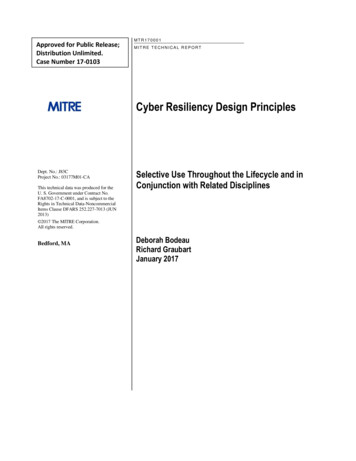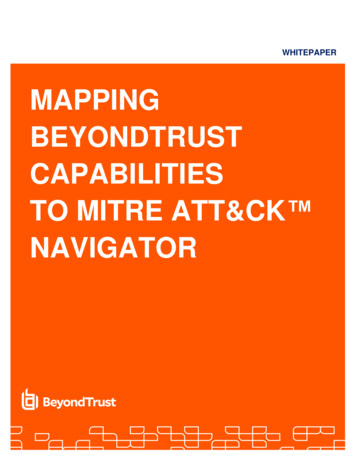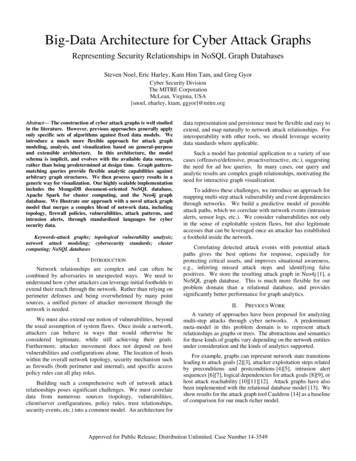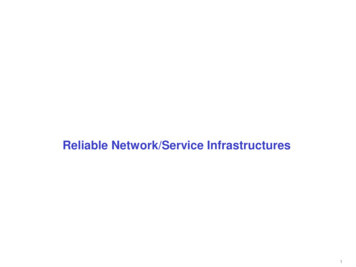
Transcription
Approved for Public Release;Distribution Unlimited.Case Number 17-0103MTR170001MITRE TECHNICAL REPORTCyber Resiliency Design PrinciplesDept. No.: J83CProject No.: 03177M01-CAThis technical data was produced for theU. S. Government under Contract No.FA8702-17-C-0001, and is subject to theRights in Technical Data-NoncommercialItems Clause DFARS 252.227-7013 (JUN2013)Selective Use Throughout the Lifecycle and inConjunction with Related Disciplines 2017 The MITRE Corporation.All rights reserved.Bedford, MADeborah BodeauRichard GraubartJanuary 2017
2017 The MITRE Corporation. All rights reserved.
AbstractCyber resiliency is increasingly an explicit concern for systems, missions, and programs. Therefore,systems engineers and architects seek ways to apply cyber resiliency concepts and to integrate resilienceenhancing technologies into architectures and designs. This paper presents a representative set of cyberresiliency design principles and describes factors to use in selecting a set appropriate to a given system,program, or system-of-systems. These cyber resiliency design principles can be used, in varying ways andto different degrees, throughout the system lifecycle, and in conjunction with design principles fromrelated disciplines, including security, resilience engineering, survivability, and evolvability. 2017 The MITRE Corporation. All rights reserved.Approved for Public Release; Distribution Unlimited. Case No. 17-0103.iii
AcknowledgmentsThe authors gratefully acknowledge the work of those who have defined and applied cyber resiliencydesign principles in a variety of situations, in particular Kate Arndt, Ken Cox, Harriet Goldman, BillHeinbockel, Ellen Laderman, Rosalie McQuaid, Linda Morrison, Jeff Picciotto, and Mindy Rudell. Inaddition, the authors are grateful for the review and improvements provided by Shawn Fagan, HarrietGoldman, Bill Heinbockel, Ellen Laderman, and Linda Morrison. 2017 The MITRE Corporation. All rights reserved.Approved for Public Release; Distribution Unlimited. Case No. 17-0103.iv
Table of Contents12Introduction . 11.1Design Principles . 21.2Overview of This Document . 31.3Notes on Terminology . 4Representative Cyber Resiliency Design Principles . 72.1Strategic Design Principles for Cyber Resiliency . 82.1.1Focus on Common Critical Assets . 102.1.2Support Agility and Architect for Adaptability . 112.1.3Reduce Attack Surfaces . 112.1.4Assume Compromised Resources. 132.1.5Expect Adversaries to Evolve . 132.2Structural Design Principles for Cyber Resiliency . 142.2.1Limit the Need for Trust . 162.2.2Control Visibility and Use . 172.2.3Contain and Exclude Behaviors . 192.2.4Layer Defenses and Partition Resources. 202.2.5Plan and Manage Diversity . 212.2.6Maintain Redundancy . 232.2.7Make Resources Location-Versatile . 242.2.8Leverage Health and Status Data . 252.2.9Maintain Situational Awareness . 262.2.10 Manage Resources (Risk-) Adaptively . 272.2.11 Maximize Transience; Minimize Persistence . 292.2.12 Determine Ongoing Trustworthiness . 302.2.13 Change or Disrupt the Attack Surface . 312.2.14 Make Unpredictability and Deception User-Transparent . 332.33Cyber Resiliency Design Principles, Objectives, and Techniques . 34Applying Cyber Resiliency Design Principles . 363.1Environmental Factors . 363.2Stakeholder Priorities . 403.3Design Principles from Related Specialty Disciplines . 413.3.1Security . 41 2017 The MITRE Corporation. All rights reserved.Approved for Public Release; Distribution Unlimited. Case No. 17-0103.v
3.3.2Resilience Engineering and Survivability. 413.3.3Evolvability, Anti-Fragility, and Changeability . 413.4Design Principles as Expressions of a Risk Management Strategy . 424Conclusion . 445References . 45Appendix ABackground on Cyber Resiliency . 53A.1Cyber Resiliency Engineering Framework . 53A.2Cyber Resiliency Design Principles and Other Constructs. 54A.3Threat Model for Cyber Resiliency . 55A.4Cyber Resiliency and Trustworthiness . 57Appendix BSources of Cyber Resiliency Design Principles. 59B.1General Cyber Resiliency Design Principles Defined Using the CREF. 59B.2Cyber Resiliency Design Principles from an Operational Perspective . 61B.3Principles Identified by Community Brainstorming . 63B.4Representative Program-Specific Statements . 65Appendix CC.1Details of Design Principles from Related Domains . 67Security . 67C.1.1Saltzer and Schroeder / Building Security In . 67C.1.2NIST SP 800-160 . 70C.1.3Security Design Principles for Digital Services. 72C.1.4Other Sources . 74C.1.5Cyber Resiliency Gaps in Security Design Principles . 74C.2Resilience Engineering . 75C.2.1Resilience Design Principles from the Systems Engineering Body of Knowledge. 75C.2.2Resilience Design Principles for a Broader Context. 77C.2.3Other Sources of Resilience Design Principles . 79C.3Survivability. 80C.3.1Survivable Systems Architecture . 80C.3.2System Survivability Key Performance Parameter . 82C.4Evolvability . 82C.5Safety . 84Appendix DGlossary and Abbreviations . 85D.1Glossary . 85D.2List of Abbreviations . 88 2017 The MITRE Corporation. All rights reserved.Approved for Public Release; Distribution Unlimited. Case No. 17-0103.vi
List of FiguresFigure 1. Representative Examples of Design Principles from Different Specialty Disciplines . 2Figure 2. Factors to Consider in Selecting and Applying Cyber Resiliency Design Principles . 36Figure 3. Stakeholder Priorities Highlight Cyber Resiliency Objectives and Corresponding HighLevel Design Principles . 40Figure 4. Aspects of Risk Management Strategy Relevant to Selection of Design Principles . 42Figure 5. The Risk Management Strategy Highlights Different Strategic Design Principles . 43Figure 6. Cyber Resiliency Engineering Framework . 54Figure 7. Cyber Resiliency Design Principles in Relation to Other Key Constructs . 54Figure 8. Cyber Attack Lifecycle. 55Figure 9. Disruption Model for Survivability or Resilience Engineering . 55Figure 10. Performance Curve Illustrating Aspects of Resilience (Figure 1 of [101]). 56Figure 11. Cyber Resiliency Against Destructive Malware . 56Figure 12. Cyber Resiliency Against Data Exfiltration or Fabrication . 57Figure 13. Notional Relationships Among Dimensions of Trustworthiness . 58Figure 14. Operational Context for Cyber Resiliency Design Principles . 61 2017 The MITRE Corporation. All rights reserved.Approved for Public Release; Distribution Unlimited. Case No. 17-0103.vii
List of TablesTable 1. Representative Cyber Resiliency Design Principles . 7Table 2. Strategic Cyber Resiliency Design Principles in Context . 9Table 3. Strategies for Reducing an Attack Surface . 12Table 4. Structural Design Principles Support Different Strategic Design Principles . 14Table 5. Examples of Restatements of Limit the Need for Trust . 17Table 6. Examples of Restatements of Control Visibility and Use. 18Table 7. Examples of Restatements of Contain and Exclude Behaviors . 19Table 8. Examples of Restatements of Layer Defenses and Partition Resources . 21Table 9. Examples of Restatements of Plan and Manage Diversity . 22Table 10. Examples of Restatements of Maintain Redundancy . 24Table 11. Examples of Restatements of Make Resources Location-Versatile . 25Table 12. Examples of Restatements of Leverage Health and Status Data . 26Table 13. Examples of Restatements of Maintain Situational Awareness . 27Table 14. Examples of Restatements of Manage Resources (Risk-) Adaptively . 28Table 15. Examples of Restatements of Maximize Transience; Minimize Persistence . 29Table 16. Examples of Restatements of Determine Ongoing Trustworthiness . 31Table 17. Examples of Restatements of Change or Disrupt the Attack Surface . 32Table 18. Examples of Restatements of Make Unpredictability and Deception User-Transparent. 33Table 19. Mapping Cyber Resiliency Design Principles to Objectives and Techniques . 35Table 20. Environmental Factors Influencing the Use of Cyber Resiliency Structural DesignPrinciples. 38Table 21. Supplementary or Alternative Design Principles from Cyber Resiliency Objectives . 59Table 22. Descriptions of Cyber Resiliency Techniques Can Be Viewed as Design Principles . 60Table 23. Cyber Resiliency Design Principles from an Industry Perspective . 61Table 24. Community-Developed Design Principles Related to Cyber Resiliency . 63Table 25. Operational Principles Related to Cyber Resiliency. 64Table 26. Examples of Program-Specific Cyber Resiliency Strategies . 65Table 26. Alternate Examples of Cyber Resiliency Strategies . 65Table 27. Examples of Cyber Resiliency Requirements . 66Table 29. “Building Security In” Security Design Principles and Cyber Resiliency . 68Table 30. Principles for Security Architecture and Design and Cyber Resiliency . 70Table 31. Design Principles for Security Capability and Intrinsic Behaviors and Cyber Resiliency. 71Table 32. Security Design Principles for Digital Services and Cyber Resiliency . 72Table 33. Security Design Principles and Cyber Resiliency Design Principles . 74Table 34. Resilience Engineering Design Principles . 76Table 35. Resilient Design Principles and Cyber Resiliency . 77Table 36. Factors for Cyber Resilience and Design Principles . 79Table 37. Examples of Strategies for Resilient Response . 80Table 38. Design Principles for Survivable Systems and Cyber Resiliency . 80Table 39. Evolvability Design Principles and Cyber Resiliency . 82Table 40. System Safety Principles and Cyber Resiliency . 84 2017 The MITRE Corporation. All rights reserved.Approved for Public Release; Distribution Unlimited. Case No. 17-0103.viii
1 IntroductionCyber resiliency is the ability to anticipate, withstand, recover from, and adapt to adverse conditions,stresses, attacks, or compromises on cyber resources. Cyber resiliency (or system resiliency1, when thedefinition explicitly includes cyber attacks among the forms of adversity to which a system must beresilient) is an emergent2 property of a system or a system-of-systems. This document presents arepresentative set of design principles for cyber resiliency, which can be applied in a variety of settings.In particular, these design principles can be used to inform activities and processes which are part ofsystems security engineering (SSE), as defined by NIST SP 800-160 [1].This document is intended for systems engineers and architects with a working knowledge of cyberresiliency concepts and technologies, who are seeking to apply those concepts and technologies by (1)identifying the corresponding cyber resiliency design principles that apply to a given system andenvironment; (2) aligning (and possibly combining) the applicable cyber resiliency design principles withdesign principles from other specialty systems engineering disciplines; and (3) analyzing how well agiven design, implementation, or as-deployed system applies a given cyber resiliency design principle.This document builds on a body of existing work on cyber resiliency, including the definition andevolution of the Cyber Resiliency Engineering Framework (CREF) [2] [3], processes for cyber resiliencyassessment [4] [5], alignment of cyber resiliency with the multi-tiered approach to risk managementdefined by the Joint Task Force Transformation Initiative [6] [7], the series of Secure & Resilient CyberArchitectures Invitationals [8] [9] [10], and application of cyber resiliency to systems and programs at avariety of stages. For more information on cyber resiliency documentation, concepts, and guidance, see[11].Cyber resiliency is increasingly recognized as a necessary attribute of systems and missions, as awarenesshas increased of sophisticated and evolving cyber threats [12]. The concern for cyber resiliency is recentrelative to the lifespans of many systems and acquisition programs. Thus, the need to improve cyberresiliency of existing systems, systems-of-systems (SoS), and enterprise architectures (EAs) is asignificant and growingconcern. The cyberThe Need for Cyber Resiliency Design Principlesresiliency designAs a systems engineering area, cyber resiliency is related to other specialtyprinciples described in thisdisciplines, including security, resilience, survivability, and evolvability. However,paper can be applied incyber resiliency assumes an advanced cyber threat – persistent, stealthy,different ways at multiplestrategic, evolving, capable of discovering (and sometimes even creating) newstages in the systemvulnerabilities and developing tactics, techniques, and procedures (TTPs) todevelopment lifecycleexploit those vulnerabilities in unforeseen ways. In addition, cyber resiliency is(SDLC) or the acquisitionmotivated by mission assurance, the overarching goal of which is to ensure thatlifecycle (ALC), includingmission objectives can be achieved, “fighting through” attacks by intelligent,the operations andsophisticated, and strongly motivated adversaries. Because other disciplines domaintenance (O&M)not make the same threat assumptions, their design principles cannot suffice tostage, and can be used in aachieve cyber resiliency.wide variety of systemdevelopment models, including agile and spiral development.1See the May 2016 Second Public Draft of NIST SP 800-160 [20]. Note that NIST now plans to publish several of theAppendices to that draft – including the resiliency appendix – as separate publications.2 An emergent property is a property of a complex system which arises from interactions among the entities that make up thatsystem. An emergent property can be accidental, but it can also be the result of engineering decisions. Examples of emergentproperties that are intended by engineering processes include security [126], safety [127], and resilience ( [1], p. 8). NIST SP800-160 observes that “Emergent properties are typically qualitative in nature, are subjective in their nature and assessment, andrequire consensus agreement based on evidentiary analysis and reasoning.” ( [1], p. 9) 2017 The MITRE Corporation. All rights reserved.Approved for Public Release; Distribution Unlimited. Case No. 17-0103.1
This introductory section provides background on design principles, an overview of this document, andnotes on terminology.1.1 Design PrinciplesIn this document, the phrase “design principles” refers to distillations of experience designing,implementing, integrating, and upgrading systems that systems engineers and architects can use to guidedesign decisions and analysis. A design principle typically takes the form of a terse statement or a phraseidentifying a key concept, accompanied by one or more statements that describe how that concept appliesto system design (where “system” is construed broadly to include operational processes and procedures,and may also include development and maintenance environments).Design principles are typically defined by specialty engineering disciplines. Figure 1 illustrates designprinciples from the specialty disciplines of Security ( [1], Appendix F), Resilience Engineering [13],Survivability [14], and Evolvability [15].3 The figure illustrates the fact that different specialty disciplinesoften share some design principles. For example, Redundancy is identified for Resilience Engineering,Survivability, and Evolvability; Modularity and Layering is a Security design principle, while LayeredDefense is a Resilience Engineering design principle. However, the meanings of these apparentlycommon design principles cannot be assumed to be identical; a design principle for a specialty disciplinecarries with it the assumptions, system and risk models, and priorities specific to that discipline. Thus, therelationship between apparently identical or similar design principles from different disciplines can becharacterized in terms of alignment: Engineers from the specialty disciplines can combine such designprinciples into a system- or program-specific design principle, providing amplifying discussion to clarifywhat the design principle means in the context of the system or program, its mission requirements andoperational environment, and the risks it can serve to mitigate. Alternately or in addition, systemsengineers can develop questions to be answered by analysis of a system design, or via analysis and testingof an as-built or as-deployed system, and define metrics or other evidence to support the analysis.Figure 1. Representative Examples of Design Principles from Different Specialty DisciplinesThe presence of “design” in the phrase “design principle” might suggest that the usefulness of designprinciples is limited to the early stages in the SDLC. However, some design principles are relevant to thedesign (or redesign) of processes, either for making more effective use of systems as those systems arebeing implemented, or during O&M. Early in the lifecycle, statements of design principles can beincorporated into a Security Plan and/or contractual requirements [8].4 Design documentation then caninclude explanations of how the design applies or is consistent with the principles. A design principle canguide the selection, de-selection, or tailoring of requirements; the allocation of requirements to specificlocation(s) in an architecture; the choice of specific technical solutions or of how such solutions areimplemented or integrated; and decisions about how to define operational processes and proceduresconsistent with an overall concept of operations (CONOPS). Later in the lifecycle, a design principle can3See Appendix C for more details on design principles for these specialty disciplines, as well as safety engineering.Contractual requirements related to design principles typically appear in a Statement of Work (SOW), rather than in aFunctional Requirements Document (FRD).4 2017 The MITRE Corporation. All rights reserved.Approved for Public Release; Distribution Unlimited. Case No. 17-0103.2
guide the selection, de-selection, or tailoring of recommended changes to the system (including changesin how it is used).In the six-step process defined by the Risk Management Framework (RMF, [16] [17] [18]), requirementsreflect the functional decomposition and allocation of security controls to the system architecture. Adesign principle is not a functional requirement, but it can be used to guide the selection, tailoring, or deselection of security controls.5 A design principle can also be used to guide the decomposition andallocation of security controls, as well as guiding implementation decisions.1.2 Overview of This DocumentSome design principles can be derived directly from the Cyber Resiliency Engineering Framework(CREF), which is described in Appendix A. Since cyber resiliency is a relatively new area, no single setof design principles has achieved consensus (as has been achieved, for example, with respect to security).However, MITRE’s experience in articulating design principles for specific programs or systems, atdifferent points in the lifecycle and for different types of systems, has demonstrated that a meaningful setof design principles needs to include statements that package one or more objectives and techniquestogether. In addition, MITRE has brought together a community of practice at the series of Secure &Resilient Cyber Architectures Invitationals [8] [9], where further experiences have been shared. Based onexperience applying cyber resiliency, a representative set of cyber resiliency design principles has beendeveloped. This set is presented in Section 2.For any given system, system-of-systems, or program, a set of cyber resiliency design principles can beselected (and tailored, to be expressed in terms more meaningful in the context of the architecture andCONOPS for missions and for system operations) using those presented in this paper as a starting point.Meaningful design principles provide the basis for engineering analysis and (where possible) metrics,to speak directly to the concerns of stakeholders. Section 2 provides examples of specific restatementsand possible metrics, and Appendix B provides alternative statements of cyber resiliency designprinciples. Note that the metrics identified in Section 2 only address how well (e.g., how completely, howconsistently) each principle is applied; metrics and other form of evidence for how effective an applicationof a design principle is, given a threat model, will be the topic of a future report.To be useful, the set of design principles should not be too large; experience suggests a set on the order ofa dozen.6 Thus, the set presented in Section 2 is a starting point, with the expectation that some will bedeemed inapplicable. No cyber resiliency design principle is universally applicable. Whether a principleis relevant to a given situation depends on a variety of factors. When a principle is relevant, the statementsdescribing how it applies will be tailored based on those factors. Section 3 describes factors to consider.Among those factors is the relationship among design principles. Even in a relatively mature disciplinesuch as security, established design principles cannot all be satisfied simultaneously. Cyber resiliencydesign principles must be used in conjunction with those from related disciplines – security, resilience ingeneral, survivability, or evolvability. Relationships discussed in Section 3 are explored in more detail inAppendix C.Three appendices are also provided. Appendix A provides background on cyber resiliency. Appendix Bprovides background on sources of potential cyber resiliency design principles, and presents someadditions or alternatives to the design principles presented in Section 2. Appendix C presents mappingsfrom design principles for related disciplines to the cyber resiliency design principles. Note that the5For a mapping of the security controls in NIST SP 800-53R4 to the cyber resiliency techniques defined in the Cyber ResiliencyEngineering Framework, see Appendix H of the Second Public Draft of NIST SP 800-160 [20]. An earlier mapping can be foundin [6].6 The set will typically include a mixture of strategic and structural design principles. See Section 2 for an explanation of theseterms. Note that, as discussed in [3], the use of some cyber resiliency techniques can interfere or conflict with the use of others. Asimilar observation can be made about design principles. 2017 The MITRE Corporation. All rights reserved.Approved for Public Release; Distribution Unlimited. Case No. 17-0103.3
details in Appendices B and C are intended for systems engineers seeking to align design principles fromdifferent specialty disciplines, rather than for the general reader.Two significant topics are outside the scope of this document: metrics or other evidence for evaluating therelative effectiveness of applications of design principles, and methods for performing cost-benefitanalyses. MI
Table 27. Examples of Cyber Resiliency Requirements . 66 Table 29. "Building Security In" Security Design Principles and Cyber Resiliency . 68 Table 30. Principles for Security Architecture and Design and Cyber Resiliency . 70 Table 31.










